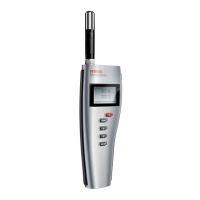Certified Humidity Standards
The ROTRONIC certified standards are available in boxes of 5 glass ampoules of the same
value, which can be stored indefinitely. Standards in the range of 5 to 95 %RH are non-
saturated aqueous salt solutions that are precisely titrated at our factory for the right
concentration. The 0 %RH humidity standard is made of small granules of a highly porous
ceramic that have been dried at a high temperature. A Material Safety Data Sheet is available
for each standard. Since most standards are a salt solution, parts which have come in contact
with the liquid should be cleaned after each use.
Each box of standards comes with a certificate that provides statistical information on the
manufacturing batch of the standard. Information on the effect of temperature on each standard
is provided on the cover of each box of standard. When calibrating either with the HygroPalm or
with the HW3 software, the effect of temperature on the standards is compensated by the
software and no further correction is required. The value of the standards is not affected by
altitude.
Instructions for using the Standards
• Install the calibration device on the probe so that the receptacle (or solution holder) is under
the probe. Check for a tight fit and remove the receptacle from the calibration device.
• Place one fibre disc (each box of standards includes 5 discs) in the receptacle of the
calibration device. The purpose of this disc is to prevent accidental spilling of the solution
inside the calibration device or on the humidity sensor.
• Tap the top of the ampoule so that all liquid drops to the bottom of the ampoule. Snap off top
and empty contents on fibre disc. Since the ampoule is made of glass, exercise proper
caution (gloves, safety glasses) when snapping off the top.
• Put the receptacle back on the calibration device and make sure that the solution does not
come in contact with the sensor: The solution inside the calibration device should never be
on top of the sensors.
• Allow at least 60 minutes to insure that the calibration device, the solution and the sensor
are in a state of equilibrium. This is verified by monitoring the display.
• After adjusting the probe, remove the receptacle from the calibration device. Throw away the
wet disc (non reusable). Thoroughly wash and wipe dry the receptacle.
General Recommendations
During calibration, temperature stability is the single most important requirement. If possible,
calibrate the probe at room temperature (18 to 25°C). Room temperature should be stable to ±
0.25°C or better during the period of time required for each calibration point. Do not calibrate
close to an air vent or a heater, in direct exposure to sun rays, etc.
If using a humidity generator to calibrate the probe, make sure that the probe is as fully
immersed in the generator as possible to minimize temperature effects.
\\Kalibrierung\Calibration_procedures_2.doc
4

